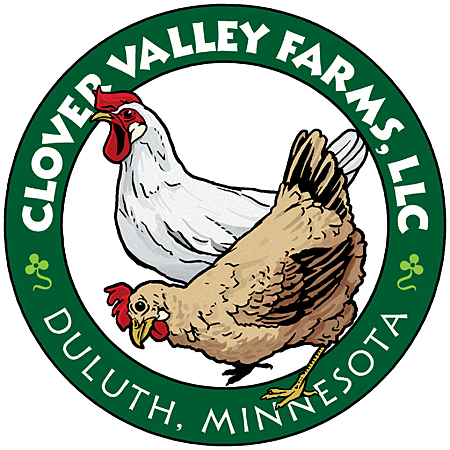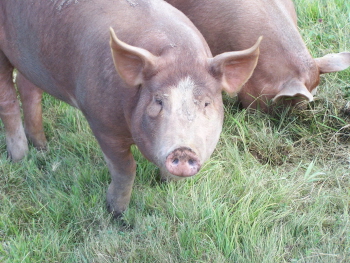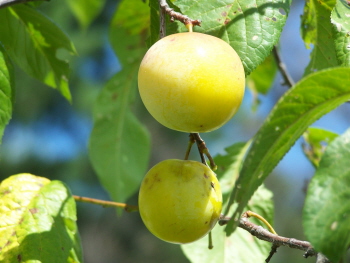Heat and Moisture Exchange
The greenhouse was originally kept detached from the living quarters out of concerns over excessive moisture being introduced to the house. In 2003, however, when Jeff and Cindy added a second story to their home, they attached the greenhouse. It is now part of a three-tiered system for heating their house. First, a thermostatically controlled fan blows air from the greenhouse into the home if the temperature in the greenhouse exceeds a certain point. When this warm, moist air is inadequate, a wood stove and electric radiant heaters installed on the walls of the house provide back-up.

Other mechanisms are in place to keep greenhouse heating and air exchange largely passive. The ridge vents in the greenhouse, for example, open and close automatically because of a resin that expands when hot and contracts when cold. There is a reversible gable fan used for air exchange with the house and a solar-powered gable fan on the far side of the greenhouse to regulate summer temperatures.
|
This entire system was permitted under an experimental septic program and benefitted from a county health inspector who was open to the plans. Cindy and Jeff work with the inspector to provide periodic data that show the system still functions. They have been pleased to be able to demonstrate, using flow meters, that they typically discharge only 50 gallons per day – a figure that was initially hardly believed! Typical household water discharge in Minnesota is about 50 to 75 gallons per person per day. See "Conserving Water" from University of Minnesota Extension for more information about household water use. Cindy and Jeff were told that septic systems for residences are typically designed to accommodate 450 gallons of discharge per day. The well on their property is shallow and slow to recharge, and Cindy and Jeff think that if not for the low level of water use in their home, they would have had to drill an additional well to accommodate their livestock production. In essence, then, they feel the greywater system has indirectly saved their farm business tens of thousands of dollars. |
Educator's Perspective: Resource Tip Livestock Water Requirements A clean and adequate supply of drinking water is critically important to good growth and health of livestock. Being thirsty –- or worse, dehydrated -- can reduce animal performance, sometimes by a lot. Adequate water consumption is just as important in cold winter temperatures as it is during hot summer weather. Planning for your livestock housing areas must include planning for a water supply; and if you will keep animals over the winter, that supply must be usable even in freezing weather. The following resources provide tables of water requirements for most types of livestock, and show the variation in water requirements with size and age of the animal, level of feed consumption, and whether it is lactating. Livestock and Water. 1999. Greg Lardy and Charles Stoltenow. North Dakota State University. Water Requirements for Poultry. 2001. W. Winchell. Canada Plan Service. Water Requirements of Livestock. 2007. Daniel Ward and Kevin McKague. Ontario Ministry of Agriculture, Food, and Rural Affairs. |
Spotlight on: Greenhouse Construction and Operation Cindy and Jeff’s greenhouse was built with “knee walls” that support the A-frame structure. The walls are bermed on the outside, up to the bottom of the windows and the top of the raised beds, providing insulation. One end of the greenhouse is attached to the house and the other end is insulated, so primary heat loss is through the polycarbonate glazing. The insulation is so effective that the greenhouse can reach 110ºF and need to be vented on a sunny day in January, when it’s -20ºF and windy outside. The angle of the glazing is designed to capture maximum penetration by the sun in the middle of winter. It’s actually easier to cool the greenhouse in the summer, when they can open the doors and have the fans going. 
Night-time warmth is maintained during winter through the use of rainwater storage tanks and barrels, which provide thermal mass. The sun heats the water during the day, and the heat is stored overnight. Air temperature in the greenhouse may drop to a few degrees below freezing at night during the coldest part of winter, but the soil in the raised beds never freezes. Effectively, the greenhouse becomes a USDA Plant Hardiness Zone 6 or 7, compared to a Zone 3 outside*. Jeff and Cindy made a point to keep the greenhouse simple to operate, including “off-the-shelf” plumbing materials such as water lines and a water meter. They use a ball valve to control how much water gets to each raised bed, and drain tile is buried underneath. There are “microclimates” within the greenhouse, so that some beds are naturally drier or colder than others. One of the “lessons learned” was about the “water wall” on the north side. It was added as an afterthought rather than being integrated into the original structure, and it worked well for about five years until the tubing started degrading. It functioned by pumping water from the holding tanks and running it down corrugated metal on the inside of the north wall when the air temperature exceeded 80º, then recapturing it in the tanks. The heat of the wall warmed the water, increasing the ability of the tanks to provide thermal mass. Cindy and Jeff eventually hope to restore the water wall’s function. Cindy and Jeff have also learned how to respond when people want to know if a greywater greenhouse “septic system” would be an easier or less expensive way to address their own septic needs. The first question Cindy and Jeff ask people is, “Do you want a greenhouse?” If the answer is not an unequivocal YES, then Cindy and Jeff suggest they reconsider their interest! They feel it important to emphasize that a greenhouse of any kind requires almost daily attention and monitoring, and that if you aren’t passionate about learning how to manage and grow plants in a greywater greenhouse, then you don’t want a system like theirs. Cindy and Jeff love their greenhouse and can’t imagine life without it, but they know it’s not for everyone.  **The USDA updated the Plant Hardiness Zones in 2012, for the first time since 1990. A new interactive map is now available. This Minnesota Public Radio article describes the changes. |
 |
 |


